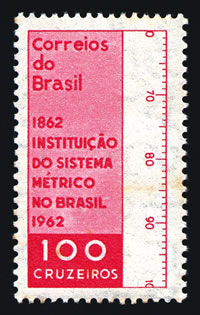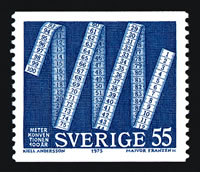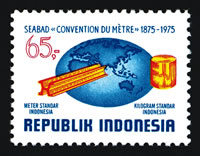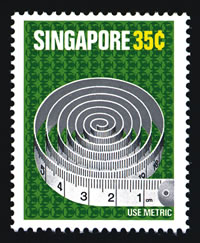|
|
Vol.
32 No. 6
November-December 2010
A Philatelic Tribute to the SI by Daniel Rabinovich
 1 1 |
Postage stamps constitute a simple yet effective way of commemorating events and educating the general public on a variety of subjects, including art, geography, history, and literature. Perhaps more surprising is that various topics in astronomy, biology, chemistry, and physics have also been showcased on stamps, even if in a somewhat more limited fashion. In this regard, a number of stamps depicting the periodic table, famous chemists, molecular formulas, and minerals have been regularly featured in the Stamps International column of this newsmagazine during the past four years. Since the International System of Units (SI) is now celebrating its 50th anniversary, this article pays tribute to the metric system and presents an assortment of postage stamps to highlight key aspects of its development and modern applications. The SI has a long and fascinating history that goes back to the turbulent years of the French Revolution (1789–1799). The first prototypes of the metre and the kilogram, made of pure platinum, were deposited with the Archives of the Republic in June of 1799, just a few months before Napoleon Bonaparte’s coup d’état and ascent to power as First Consul in November of that year. The metric system slowly spread to other countries in Europe and South America in the ensuing decades even though alternative units of measurement were still prevalent in many other regions of the world. Brazil was one of the first countries to adopt the metric system (1862) and a stamp [1] was issued 100 years later to remember the milestone. In a similar vein, the metric system was introduced in Romania in 1864 and a stamp [2] showing the original definition of the metre (i.e., one ten-millionth of the quadrant of the Earth, measured from the North Pole to the Equator) was released in 1966.
The quest for a more broadly recognized system of measurements led in 1875 to the Convention du Mètre, where the International Bureau of Weights and Measures (BIPM) was created to oversee the implementation of universal metric standards. Under the terms of the Convention, new prototypes for the metre and the kilogram made of an improved platinum-iridium alloy (90:10) were prepared and distributed to the members of the Bureau by the time the first General Conference of Weights and Measures (CGPM) met in 1889. Several countries issued stamps in 1975 to observe the centennial of the Meter Convention, including the Netherlands [3], Romania [4], Surinam [5], and Sweden [6]. Remarkably, stamps issued by Bulgaria [7] and Indonesia [8] also displayed a small cylinder to represent the International Prototype Kilogram (IPK) and an X shaped bar for the International Prototype Metre.
 |
|
6 |
 |
8 |
7 |
The 10th CGPM (1954) introduced the ampere, the kelvin, and the candela as the base units of electric current, temperature, and luminous intensity, respectively. The name SI was finally adopted in 1960 at the 11th CGPM, which also approved a new definition of the metre as 1 650 763.73 wavelengths of the radiation corresponding to the transition between the 2p10 and 5d5 energy levels in an atom of krypton-86. This definition, abstruse perhaps, but quite precise, was a consequence of the development of the interferometer by Albert A. Michelson, the first American to receive the Nobel Prize in Physics (1907), and other technological advances that occurred during the first half of the 20th century. Interestingly, a French stamp issued in 1975 for the centennial of the Metre Convention [9], four years after the mole was added to the SI as the base unit for the amount of substance during the 14th CGPM, shows the symbols of the seven base units surrounding an atom of krypton-86. The names of the seven base units appear in a stamp from Cuba that specifically recognizes the SI [10]. It is also worth mentioning that the metre was redefined yet again during the 17th CGPM (1983) based on the speed of light in a vacuum (299 792 458 metres per second).
 |
15 |
What is going to happen with the SI in the next 50 years? The kilogram is the only SI unit that is still defined by an artifact but, surprisingly, it has been found that the mass of the IPK changes slightly over time (just a few micrograms per decade, but a measurable variation nevertheless). Thus, the International Committee for Weights and Measures (CIPM) has recommended that the kilogram be redefined in terms of Planck’s constant, and this issue will be addressed at the upcoming 24th CGPM in 2011. The metric system is also likely to continue spreading in Liberia, Myanmar, and the United States, the only three countries where the use of the SI is recommended but still not officially mandated. Although the use of the metric system is already the norm in chemical education and research, will such practice extend to other aspects of daily life? Will food products be sold everywhere in kilograms and road signs in highways displayed in kilometres? Several countries have issued stamps to promote the use of the SI, including Japan [11], Bangladesh [12], Kenya, Uganda, and Tanzania [13], Pakistan [14], and Singapore [15]. So, on the golden jubilee of the SI, let’s hope the trend continues . . .
Daniel Rabinovich <[email protected]> is a professor of chemistry at The University of North Carolina at Charlotte, with research interests in synthetic and structural inorganic, bioinorganic, and organometallic chemistry. He is also the editor of Philatelia Chimica et Physica, a quarterly publication dedicated to the study of postage stamps related to chemistry and physics.
Page
last modified 18 November 2010.
Copyright © 2003-2010 International Union of Pure and Applied Chemistry.
Questions regarding the website, please contact [email protected] |